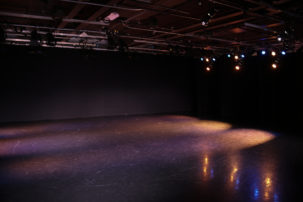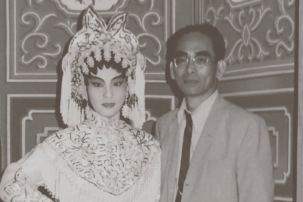What does it mean to thrill at the sight of nature when its destruction feels inevitable? How do we reckon with the deep time of the landscape and the entangled conditions colonialism has produced between humans, animals and the land? These are some of the complex questions raised by Meryl McMaster’s latest body of work, aptly titled As Immense as the Sky. Richly saturated landscapes dominate the new series of photographs and, in the place of the tight close-ups of the artist’s hands and face that characterized her earlier bodies of work, Wanderings (2015) and In-Between Worlds (2010–15), here the artist has pulled the camera back, providing full-length views of the figure. McMaster is her own photographic subject, but these are not quite self-portraits. Dressed in elaborate handmade costumes and carrying a variety of intricate props, she performs a range of historic, mythical and invented characters. The artist describes the breathtaking landscapes she inhabits as “immense time capsules of buried knowledge.” At the Ryerson Image Centre in Toronto, where the photographs were on view this past summer, paragraphs of text, first in Cree, and then in English, accompanied each image, offering multiple perspectives on the scene. Together, the images and words conveyed a narrative of photographic exploration and material transformation, but also of environmental precarity and colonial dispossession.
My Destiny is Entwined With Yours (2019), for instance, shows McMaster standing at the crest of a cliff, her back to the camera, gazing out at the horizon. She is barefoot, the skin on her hands and feet painted a bright crimson. From a braid that trails out from under her felt hat hangs a long string of tiny bells, the kind stitched to contemporary jingle dresses. Her outfit is magisterial—she carries a pronged wooden staff in one hand—and she is accompanied by a pair of teal birds. In the distance, a rain cloud looms.
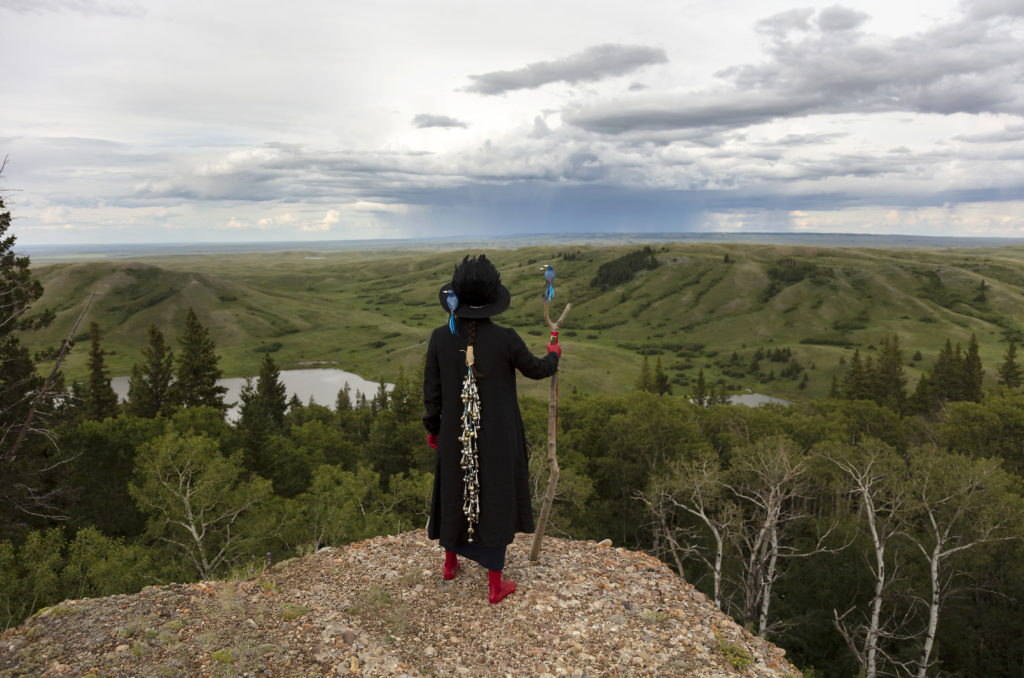
Meryl McMaster, My Destiny is Entwined With Yours from the series As Immense as the Sky, 2019. Digital C-print, 40 x 60 in. Courtesy Stephen Bulger Gallery, Toronto / Pierre-François Ouellette art contemporain, Montreal. © Meryl McMaster.

Meryl McMaster, Dream Catcher from the series Wanderings, 2015. Archival pigment print on watercolour paper, 33 x 66 in. Courtesy Stephen Bulger Gallery, Toronto / Pierre-François Ouellette art contemporain, Montreal. © Meryl McMaster.

Meryl McMaster, Colonial Drift from the series Wanderings, 2015. Archival pigment print on watercolour paper, 46 x 16 in. Courtesy Stephen Bulger Gallery, Toronto / Pierre-François Ouellette art contemporain, Montreal. © Meryl McMaster.
The image and the troubling questions it raises were still at the forefront of my mind when, a few weeks after her opening at Ryerson, McMaster and I met in a bustling coffee shop along Queen Street West to talk about the new work, and her busy year ahead. We had not seen one another for almost four years, and while her photographs have changed in that time, her demeanor has not. Though barely into her 30s, McMaster has a quiet calmness about her that at first seems to match her self-description as an introvert. But she is also profoundly curious, as her images attest, and animated when she describes planning out and making her works. Where her earlier photographs were made close to home, the latest series was staged farther afield, in Saskatchewan, Newfoundland and Southwestern Ontario, at locations where she would often have to haul her elaborate costumes and photographic equipment great distances to set up a shoot to make her images. Temperamental weather—including extreme wind warnings along the Prairies and on Manitoulin Island—added another unpredictable layer to her process. “There is a certain adrenaline rush that comes with exploring an environment for the first time,” she reflects. This leant the new works a sense of urgency, but also contingency, prompting her to work more intuitively.
The pressures, both internal and external, seem to have paid off. While many would think of this as a watershed year in her career, McMaster describes the number of high-profile international exhibitions she has participated in as simply as “a new stage in my career.” This past winter, in February, her work was included in the ninth Manif d’art biennial in Quebec City before she opened a solo exhibition at Ryerson as part of the Scotiabank CONTACT Photography Festival in May. Two months later she flew to Sydney to open “Aski Earth Terre Yarta,” a two-person exhibition at the Australian Centre for Photography with the artist James Tylor. This fall, she is part of the main exhibition at the renowned Les Rencontres d’Arles photography festival in the south of France before participating in an exhibition on Indigenous survivance at the Kupferberg Holocaust Centre in New York state. In December, she takes the entire As Immense as the Sky series to a solo exhibition at Ikon Gallery in Birmingham, UK. These exhibitions see McMaster taking up a larger footprint, literally—in the amount of gallery space devoted to her images—but also conceptually. “I’ve been thinking about audience in a new way as I write artist statements for each show,” McMaster tells me. “How to contextualize the work so viewers can enter it and understand it.”
Showing her work in places she has never visited, and where the audience might not know much about Canadian history, or the landscape, has also offered McMaster opportunities for different conversations about her photographs. In these places, the very terminology of how she is identified also changes. “I’m still solely a ‘Native American’ artist when I show in the United States,” she reminds me. Despite the surge of international biennials and art fairs in the past two decades that might indicate we have entered a truly global, and increasingly decolonial, contemporary art market, it is difficult to ignore how vigorously national narratives make themselves felt in the framing of her work. In other places, including the United Kingdom, the term “Indigenous” is rarely part of art discourse at all. “In the UK, there’s a very different history, and awareness, of Indigenous peoples. For that reason it’s an important and interesting place to keep showing my work.”
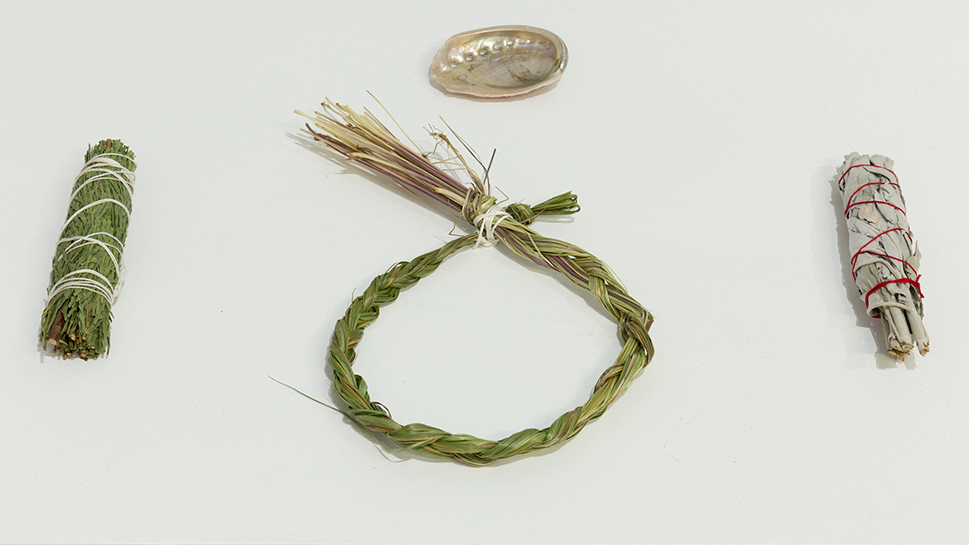 Meryl McMaster, objects from “Aski Earth Terre Yarta,” Australian Centre for Photography, Sydney, 2019. Clockwise: cedar (Thuja occidentalis), abalone shell (Haliotis), white sage (Salvia apiana), sweetgrass (Hierochloe odorata). Photo: Michael Waite.
Meryl McMaster, objects from “Aski Earth Terre Yarta,” Australian Centre for Photography, Sydney, 2019. Clockwise: cedar (Thuja occidentalis), abalone shell (Haliotis), white sage (Salvia apiana), sweetgrass (Hierochloe odorata). Photo: Michael Waite.
“I don’t yet feel ready to show my costumes and props in the gallery…For me, the work has always been about the photographs.”
These international opportunities have also brought with them a chance for McMaster to re-examine her use of materials. At the Australian Centre for Photography, where McMaster was asked to choose an Australian photographer to exhibit alongside her work, she selected Tylor for his intimate engagements with historical photographic processes and the land, but also for his use of small, ceremonial objects displayed as sculptures in the gallery. “I don’t yet feel ready to show my costumes and props in the gallery,” McMaster explains. “For me, the work has always been about the photographs.” Instead, she brought traditional smudging materials—including sage, cedar, sweet grass and an abalone shell—to exhibit on a plinth. Though they do not appear in her final images, these ceremonial objects are important to McMaster’s cultural inheritance, she says, and serve as a way of suggesting her body’s presence in the gallery when she isn’t there.
Writing, too, has become an increasingly important part of the ritual of making her works. The texts McMaster wrote for each of the images at the RIC began as a series of traditional extended labels, meant to accompany each photograph, but “I couldn’t get all of the ideas into 100 words and didn’t want to impose a single meaning onto the images,” McMaster says. In consultation with curator Gaëlle Morel, she decided to pull words and sentences from the draft labels to create poems, which allowed her to disregard the rules of grammar, rearrange the elements and hire a Cree translator. Written after the photographs were produced, the poems helped generate titles for many of the works and to concretize a creative process that McMaster describes as “starting from an idea that you might not yet understand.” From a Still Unquiet Place (2019) was taken in Red Pheasant First Nation in Saskatchewan, where her father’s family hails from, and shows the artist standing in a wide marsh, her face obscured by a plume of huge feathers. Dressed in a tartan cinched around her waist, she wears an enormous necklace of lockets—each protecting a small photographic portrait of a family member—and awkwardly holds out a pair of hand bells toward the viewer. The accompanying poem speaks to the tension between sound and silence; of both seeking to hail and also to ward off the spirits of the site:
Beckoning a connection to the history and culture of this place.
Seeking those who came before.
A childhood home.
nohtāwiy
Longing.
A place that has experienced times of peace and struggle.
Carrying ancestors.
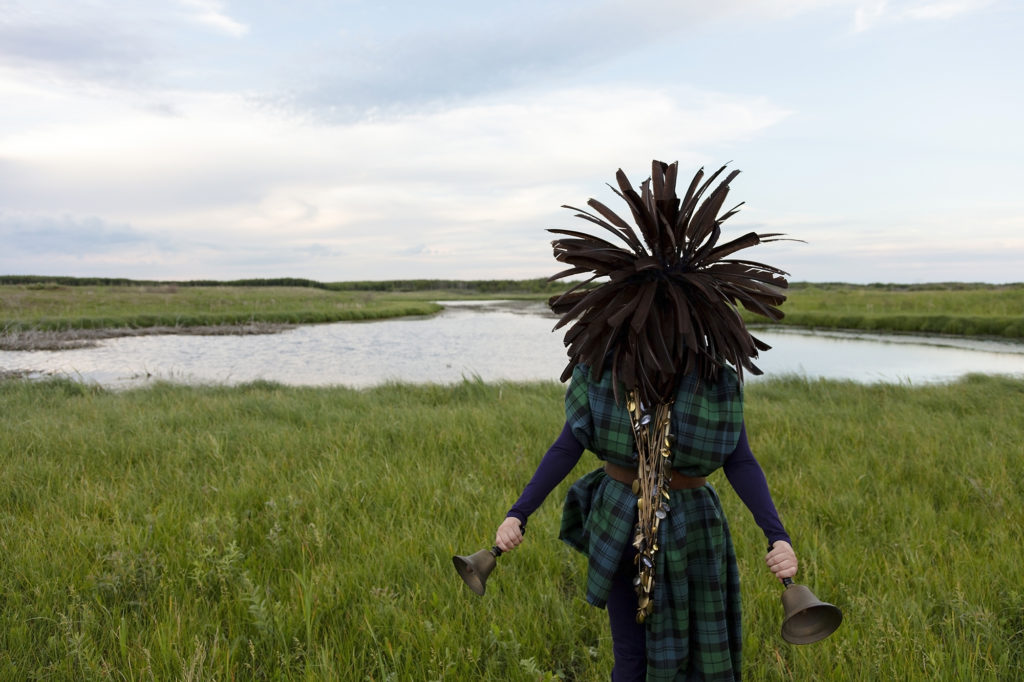
Meryl McMaster, From a Still Unquiet Place from the series As Immense as the Sky, 2019. Digital C-print, 40 x 60 in. Courtesy Stephen Bulger Gallery, Toronto / Pierre-François Ouellette art contemporain, Montreal. © Meryl McMaster.

Meryl McMaster, Wingeds Calling Variation II, 2015, from the series In-Between Worlds (2010–15). Digital C-print, 24 x 36 in. Courtesy Stephen Bulger Gallery, Toronto / Pierre-François Ouellette art contemporain, Montreal. © Meryl McMaster.
Birds are recurring and sometimes contradictory figures in McMaster’s practice. They appear as references to Cree stories about the character Raven, who puts the sun back into the sky after it is stolen by a man. In her work, they also operate as menacing authorities, and as surrogates for a different perspective on the world. “Birds are messengers, guides and protectors in our stories,” the artist once told Anishinaabe curator Wanda Nanibush. “I want to think from our relationship to them, how they see from a different vantage point…what it is to feel free from restriction.” Such a view is at odds with the fixity of a one-point, or “bird’s-eye,” perspective that has dominated the history of Western art, and offers a radical rethinking of human-animal relations in the landscape.
That McMaster is optimistic about the freedoms that exhibiting her work abroad might produce is no surprise. The work of Indigenous and racialized artists in Canada is all too often overdetermined by their cultural biographies. Turn to any feature, interview or review covering McMaster’s work and, inevitably, around the second paragraph, you will find the same markers of her ancestry dropped in, copied nearly verbatim. “McMaster, who is of mixed Plains Cree and European heritage,” is then followed, with the same inevitability, by the intimation that her playful performances are an attempt to work through her hybridized, dual or “in-between” identity. “I think those labels grew out of my series In-Between Worlds, as I had mentioned in talks and interviews that one of the ideas I was working through within that body of work was my coming to terms as a young person belonging to two different cultural heritages,” she told me later by email. “Though important to the reading of that particular series, that is not how I feel about the evolution of my practice as a whole.” When I asked her about how these labels impacted the reading of her work, she paused.
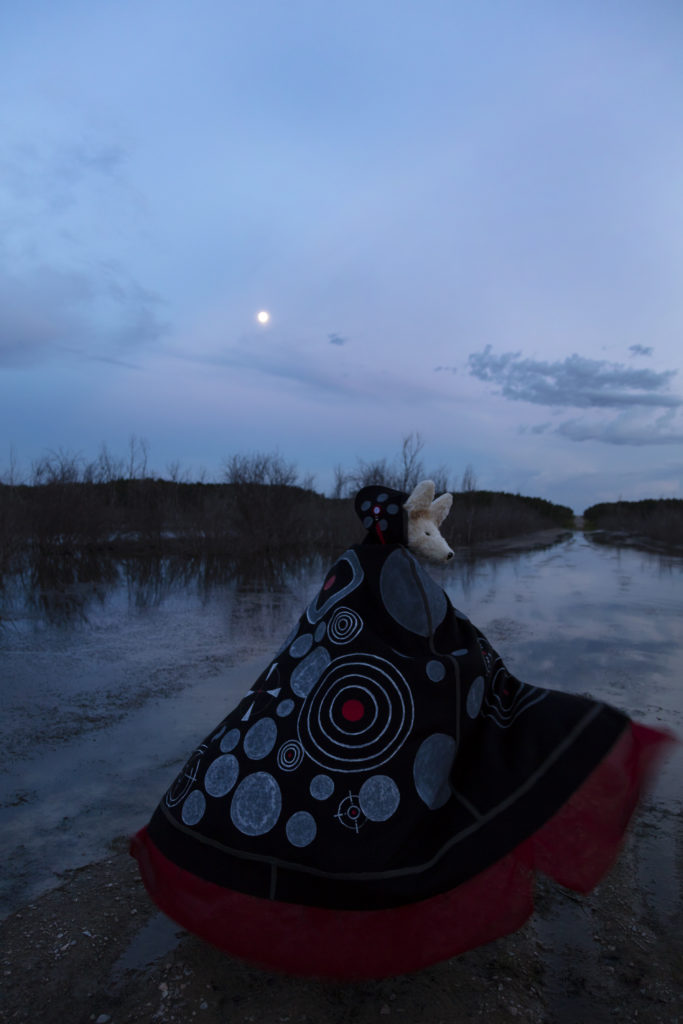 Meryl McMaster, Deep Into the Darkness, Waiting from the series As Immense as the Sky, 2019. Digital C-print, 60 x 40 in. Courtesy Stephen Bulger Gallery, Toronto / Pierre-François Ouellette art contemporain, Montreal. © Meryl McMaster.
Meryl McMaster, Deep Into the Darkness, Waiting from the series As Immense as the Sky, 2019. Digital C-print, 60 x 40 in. Courtesy Stephen Bulger Gallery, Toronto / Pierre-François Ouellette art contemporain, Montreal. © Meryl McMaster.
“I hope that over the years I’ve made it clear that there is not just one lens through which you can read my work. Most recently my mind has been preoccupied with broader questions of understanding the land and my environment and my connection to my history and lineage. It’s not so much in a conflicted way as was expressed in earlier works, but in a more exploratory way. It isn’t that those issues are entirely settled for me, but I don’t think about them quite as intentionally within my art. If people want to look at the work with a focus on multicultural tension, I think that’s fine, but I hope there is much more to be experienced by a broad range of people.”
“I hope that over the years I’ve made it clear that there is not just one lens through which you can read my work…I hope there is much more to be experienced by a broad range of people.”
Part of this broader perspective comes from the reparative work that McMaster is undertaking to teach herself her ancestral history as she makes images. “I am still learning the Plains Cree language, my own family history,” she tells me, “and I am also concerned about how we relate to and treat our environment.” While many of her early works were made in the studio—such as Ancestral (2008–10), her well-known series of portraits of her and her father, the curator Gerald McMaster, posing with historic depictions of Indigenous figures by Edward S. Curtis, William S. Soule and Geroge Catlin projected onto their faces, made during her undergraduate degree at OCAD University—or along the Ottawa River near her home, the new works are site specific, made during brief periods of intense travel. Her process for selecting locations not only entails site scouting—often conducted through the strange aerial perspective provided by Google Earth satellite imaging—but also a research-intensive process of consulting books and oral histories, particularly through the storytelling traditions of knowledge keepers in the neighbouring reserves. These processes take time, especially in building relationships with mentors and family members, and require a recursive approach to the understanding of the history of a place. “You think you know a place, but then you uncover stories about a location that add a new layer to the images,” she says. McMaster wants to continue working on location, further abroad, including in the North of Canada and in England and Scotland, where her maternal family originates. She is also trying to learn Plains Cree. Her goal, she tells me, is to one day be able to read her artist statement entirely in the language to herself.

Meryl McMaster, Ordovician Tide I from the series As Immense as the Sky, 2019. Digital C-print, 40 x 60 in. Courtesy Stephen Bulger Gallery, Toronto / Pierre-François Ouellette art contemporain, Montreal. © Meryl McMaster.

“Meryl McMaster: As Immense as the Sky” (installation view), 2019. © Larissa Issler. Courtesy Ryerson Image Centre.

“Meryl McMaster: As Immense as the Sky” (installation view), 2019. © Larissa Issler. Courtesy Ryerson Image Centre.

“Meryl McMaster: As Immense as the Sky” (installation view), 2019. © Larissa Issler. Courtesy Ryerson Image Centre.

Meryl McMaster, Ancestral 9, 2008. Digital C-print, 40 x 30 in. Courtesy Stephen Bulger Gallery, Toronto / Pierre-François Ouellette art contemporain, Montreal. © Meryl McMaster.
In McMaster’s self-portraiture, the artist is subject and object simultaneously, perhaps making it easy for critics to collapse her biography and her output. But the frequent focus on her cultural background also has the unfortunate side effect of limiting the network of relations that can be drawn between McMaster’s work and that of her creative predecessors. While she often cites the American artist Nick Cave’s Soundsuits as an important source of inspiration for her costumes, McMaster’s fleeting performances in the landscape that parallel the fragility of the natural world with that of the female body also recalls, for me, the photographs made by Cuban American artist Ana Mendieta. In her ability to easily inhabit both the dramatic and comedic, the masculine and the feminine, I also see McMaster’s work indebted to the legacy of Cree, Saulteaux and Métis artist Lori Blondeau. As performers as well as photographers, these artists use their bodies as another site of inscription on the already layered meanings of the natural landscape. Their images question what it means to act as a figure in front of the ground, to perform in these bodies when, as the Cree scholar and poet Billy-Ray Belcourt writes, “the state of ‘having’ or ‘being in’ a body is radically cramped under conditions of contemporary colonialism.” In these conditions, Belcourt argues, Indigenous embodiment has much to teach us about the fantasy of individual sovereignty, and its inherent limits.
Like many white settler viewers, I am still teaching myself the unedited version of Canadian history, of the state’s violent dispossession of the land from Indigenous peoples, and my complicity within it. Like the never-ending skies in McMaster’s latest series, this is work that does not end and must stretch long into the future. Near the gallery doors at the Ryerson Image Centre, Between the Start of Things and the End of Things I (2019), one of the final images in the series, feels like an ellipse within, rather than a conclusion to, the show. In it, McMaster stands atop a huge rock formation amid scrubby plains. In its outcroppings and shadows, I cannot help but see a face, even as McMaster’s is obscured by the huge headpiece of poplar leaves, local sage, wire, raw wool (to simulate bison hair) and various beads that crowns her head. Perhaps this time the character is a Victorian-era settler, such as Laura Ingersoll Secord, a distant family relative and the subject of one of the artist’s earliest performances for the camera. She wears what looks like a bag, strapped diagonally across her chest, clearly on a journey somewhere but stopping briefly on the only recognizable landmark in sight. From that height, McMaster’s alter ego must be able to see far into the distance, and I can’t help but wonder what she sees.

Meryl McMaster, Between the Start of Things and the End of Things I from the series As Immense as the Sky, 2019. Digital C-print, 40 x 60 in. Courtesy Stephen Bulger Gallery, Toronto / Pierre-François Ouellette art contemporain, Montreal. © Meryl McMaster.

Meryl McMaster, Between the Start of Things and the End of Things II from the series As Immense as the Sky, 2019. Digital C-print, 40 x 60 in. Courtesy Stephen Bulger Gallery, Toronto / Pierre-François Ouellette art contemporain, Montreal. © Meryl McMaster.

Meryl McMaster, Between the Start of Things and the End of Things III from the series As Immense as the Sky, 2019. Digital C-print, 40 x 60 in. Courtesy Stephen Bulger Gallery, Toronto / Pierre-François Ouellette art contemporain, Montreal. © Meryl McMaster.

Meryl McMaster, Between the Start of Things and the End of Things (triptych) from the series As Immense as the Sky, 2019. Digital C-prints, 40 x 60 in. each. Courtesy Stephen Bulger Gallery, Toronto / Pierre-François Ouellette art contemporain, Montreal. © Meryl McMaster.

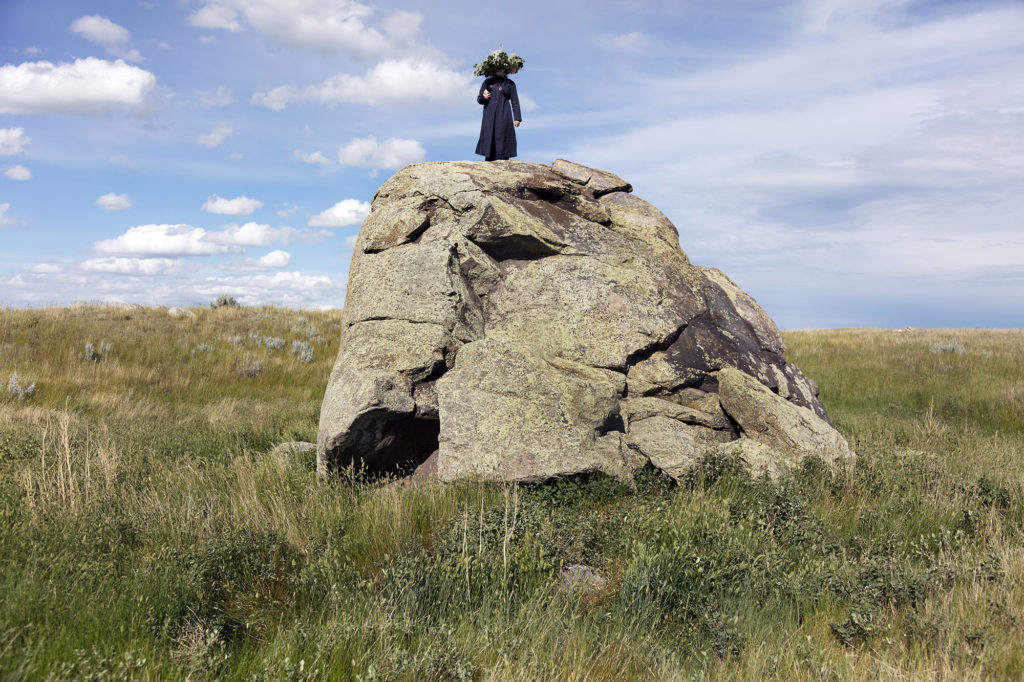 Meryl McMaster, Between the Start of Things and the End of Things (part I of triptych, shown below) from the series As Immense as the Sky, 2019. Digital C-print, 40 x 60 in. Courtesy Stephen Bulger Gallery, Toronto / Pierre-François Ouellette art contemporain, Montreal. © Meryl McMaster.
Meryl McMaster, Between the Start of Things and the End of Things (part I of triptych, shown below) from the series As Immense as the Sky, 2019. Digital C-print, 40 x 60 in. Courtesy Stephen Bulger Gallery, Toronto / Pierre-François Ouellette art contemporain, Montreal. © Meryl McMaster.

